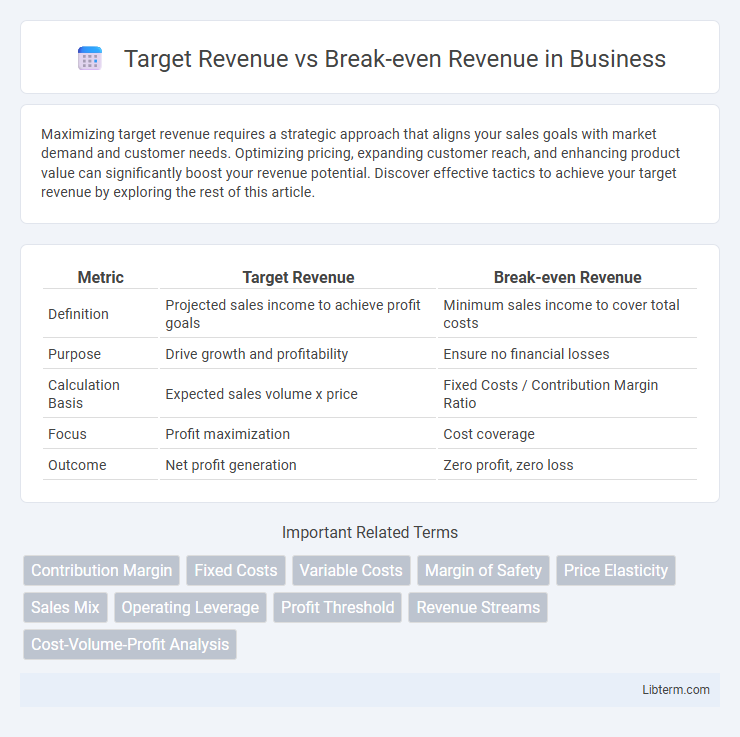Maximizing target revenue requires a strategic approach that aligns your sales goals with market demand and customer needs. Optimizing pricing, expanding customer reach, and enhancing product value can significantly boost your revenue potential. Discover effective tactics to achieve your target revenue by exploring the rest of this article.
Table of Comparison
| Metric | Target Revenue | Break-even Revenue |
|---|---|---|
| Definition | Projected sales income to achieve profit goals | Minimum sales income to cover total costs |
| Purpose | Drive growth and profitability | Ensure no financial losses |
| Calculation Basis | Expected sales volume x price | Fixed Costs / Contribution Margin Ratio |
| Focus | Profit maximization | Cost coverage |
| Outcome | Net profit generation | Zero profit, zero loss |
Understanding Target Revenue
Target revenue represents the sales amount a business aims to achieve to cover all fixed and variable costs while generating desired profit levels. It is calculated by adding the break-even revenue, which covers total costs, to the additional revenue needed for profit goals. Understanding target revenue enables companies to set realistic sales targets and improve financial planning strategies.
What Is Break-even Revenue?
Break-even revenue represents the exact amount of sales income a business must generate to cover all fixed and variable costs, resulting in zero profit or loss. It is a critical financial metric for determining the minimum revenue threshold needed to avoid losses. Understanding break-even revenue helps businesses set realistic target revenue goals to ensure profitability and sustainable operations.
Key Differences Between Target and Break-even Revenue
Target revenue represents the sales level needed to achieve a specific profit goal, while break-even revenue is the amount required to cover all fixed and variable costs without making a profit or loss. Break-even revenue marks the financial threshold where total costs equal total revenue, serving as a critical point for business sustainability. Target revenue exceeds break-even revenue by incorporating desired profit margins, reflecting a company's growth and profitability objectives.
Importance of Target Revenue in Business Planning
Target revenue represents the sales volume a business aims to achieve to ensure profitability beyond the break-even point, where total revenue equals total costs. It serves as a critical benchmark in business planning, guiding resource allocation, pricing strategies, and marketing efforts to drive sustainable growth. Accurately setting and striving for target revenue helps companies manage cash flow, attract investment, and evaluate performance against financial goals.
Calculating Break-even Revenue: Formulas & Examples
Break-even revenue is calculated by dividing total fixed costs by the contribution margin ratio, where the contribution margin ratio equals (Sales Revenue - Variable Costs) divided by Sales Revenue. For example, if fixed costs are $50,000 and the contribution margin ratio is 40%, the break-even revenue is $50,000 / 0.40 = $125,000. This calculation helps businesses determine the minimum sales revenue required to cover all fixed and variable costs before generating profit.
Factors Influencing Target Revenue
Target revenue is influenced by fixed and variable costs, desired profit margins, and market demand elasticity, which determine pricing strategies and sales volume goals. Break-even revenue is calculated to cover all fixed and variable expenses without profit, serving as a baseline for financial planning. Variations in cost structures, competitive pricing, and consumer behavior significantly impact the differentiation between break-even and target revenues.
Factors Affecting Break-even Revenue
Break-even revenue is influenced by fixed costs, variable costs per unit, and the selling price per unit, which collectively determine the volume of sales needed to cover total expenses. Higher fixed costs or lower selling prices increase break-even revenue, while efficient cost management and pricing strategies can lower it. Understanding contribution margin ratio is essential, as it directly impacts the break-even point and helps businesses optimize revenue targets.
Benefits of Monitoring Both Revenue Metrics
Monitoring both target revenue and break-even revenue provides critical financial insights that help businesses balance growth ambitions with operational sustainability. Tracking break-even revenue ensures that all fixed and variable costs are covered, preventing losses, while target revenue focuses efforts on profitability and expansion goals. This dual approach supports informed decision-making, enabling proactive adjustments to pricing, sales strategies, and cost management to maximize overall financial performance.
Common Mistakes When Setting Revenue Goals
One common mistake when setting revenue goals is confusing target revenue with break-even revenue, leading to unrealistic expectations and financial mismanagement. Target revenue includes desired profit margins beyond covering costs, whereas break-even revenue only covers total expenses without generating profit. Failing to differentiate these can result in underestimating necessary sales efforts and cash flow needs, jeopardizing business sustainability.
Strategies to Achieve Target and Surpass Break-even Revenue
To achieve target revenue and surpass break-even revenue, businesses should optimize pricing strategies and boost sales volume through targeted marketing campaigns that focus on high-margin products. Implementing cost control measures and improving operational efficiency reduces fixed and variable expenses, thus lowering the break-even point and increasing profitability. Leveraging data analytics to track customer behavior and market trends enables informed decision-making that drives revenue growth beyond break-even thresholds.
Target Revenue Infographic

 libterm.com
libterm.com